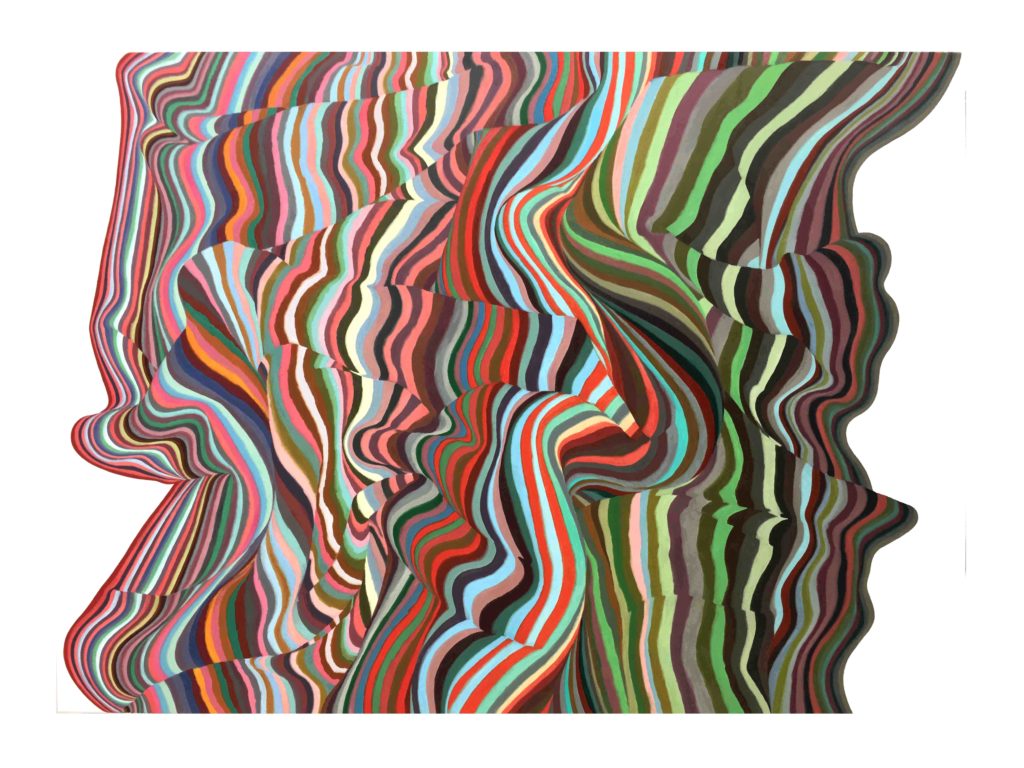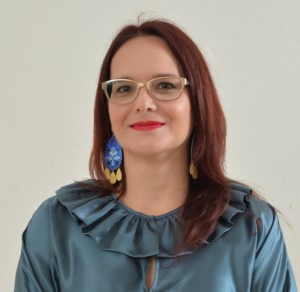Geometries of Culture with Helen Smith

Western Australian artist Helen Smith’s practice is influenced by a formal, minimalist viewpoint with simplicity of form and geometric abstraction generally contributing to the outcome. Oil on canvas paintings, large scale wall works (quite often completed as projects with her collaborator in life Jeremy Kirwan-Ward) and a number of ongoing photographic series derived from an interest in social and cultural systems form the basis for her enquiry.
She has been an active member of the Australian Centre for Concrete Art (AC4CA) since 2002 and the Art Collective WA based in Fremantle. The Art Collective WA exists to improve visibility for Western Australian visual artists, in particular those that have been living and working in WA for many years.
Blue Highway was recently presented at the Art Collective WA Art Gallery in May 2018. Here she speaks with Out Front Curator Marielle Soni.
MS: Can you describe your early days as an artist in WA? Were there people who influenced you?
HS: I graduated from Curtin University with honours in 2000 and subsequently showed work with Goddard de Fiddes Gallery, a prominent Gallery in Perth at the time that represented both national and international artists of note. I have a tremendous admiration for, and soon forged friendships with many of these artists through working together on projects with the Australian Centre for Concrete Art (AC4CA).
The AC4CA was initiated here in Perth by Julian Goddard in 2001 and developed from local artists having conversations in coffee shops, to large scale wall projects located in Fremantle, Perth and France. Its members consisted of like-minded artists and academics from Europe and the Eastern states of Australia. This relatively small group has been working together for 14 years now and the friendship and expertise this global alliance has contributed to my art practice is vast. So influential peers I could name are… Melbourne based artist John Nixon and International artists, David Tremlett (who has a permanent work at the Tate Britain), Jan van der Ploeg (the Netherlands) Daniel Goettin (Switzerland) and academic Hubert Besacier (France). West Australian artists I could mention who have influenced my practice include Jeremy Kirwan-Ward, Carol Rudyard, Julianne Clifford, Penny Bovell, Karl Wieke, Cathy Blanchflower, Jurek Wybraniec and Alex Spremberg.
I was also privileged to be a friend of John Stringer, who supported my practice and encouraged me greatly in the early years of my career.
MS: What informs your painting practice – conceptually/theoretically/aesthetically?
HS: An interest in social and cultural systems has provided material used for many art works, with a formalist, minimal view point generally informing the outcome. The results are often disproportionate, considering the amount of incoming information and the visual outcome. So both the paintings and photography in my practice could be described as minimal, and visual correlations between the two medium are surprisingly apparent. The rumples of sheets on a bed and the undulations of lines in the Alighiero e Boetti from Wikipedia paintings for instance, though coming from entirely different sources, the formal similarities are evident.
The Alighiero e Boetti from Wikipedia Series of paintings come from a conceptual basis. Boetti is well known for a series of embroidered maps of the world, Mappa, created between 1971 and his death in 1994… he took a keen interest in the relationship between chance and order, in various systems of classification (grids, maps, etc). It is Boetti’s interest in ‘order and disorder ‘1, relative to the harmony of human society, along with a visit to the Alighiero Boetti: Game Plan exhibition at the Tate Modern in 2012 that set up the concept for the series of paintings “Alighiero e Boetti from Wikipedia”.
The process of painting begins by collecting the information for a selected alliance from Wikipedia, I then work out the divisions for the components, a grid is constructed and subsequently, the collated data determines the outcome of each work. The national components of the alliances are depicted by lines of colour, proportionally mixed from the colour designs of the national flags, ie the flag is the formula for the colour of each undulating line. Italy for instance is signified by mid, muddy grey… equal parts red, white and green, and Japan – pink, and so the list goes on. The paintings are basically a record of data pertaining to each alliance at the time of painting, ideally not opinionated, but hopefully posing some questions…. the potency of Wikipedia as a reliable source of social and political policy, the effectiveness of these alliances to achieve a desired working mandate.
So I could also suggest the paintings reference the idea of how cause and effect determines the activity of matter in physics, relates in some way to how we a line ourselves or organise ourselves in groups in global terms. By distorting the underlying grid format of the works, the visual components pull and push against each other, fluctuating around a state of equilibrium ie existence of each alliance.
The resulting works that are content based and the aesthetics are of lesser importance.

MS: Can you discuss your use of colour?
HS: I find reactions to colour intriguing and my use of colour is usually relative to conative responses. From 1998 I have been working on a series of The Pink Monochromes were informed by the concept of using colour as a signifier and it’s the emotive charge of this particular colour that interests me. These were initially painted at the same time I was photographing the Bordello Series and I think are a reductive response to the photography, in that content has been reduced to colour. There has consistently been this dual element to my practice and I find the paintings and photography inform each other to a degree. Colours like yellow and orange are taken from the urban landscape where they are employeed as alerts or for hazard warnings. Inthe painting Blue highway #33 the yellow field of paint is quite arresting and consuming and I guess its the physical response of a colour that interests me.
As discussed earlier in the Alighiero e Boetti from Wikipedia Series the use of colour was entirely pragmatic as once the alliance for each painting was determined the colours were predetermined by the list of countries involved.
In the Blue Highway Series based on the name of a font developed in the early 1990s, I was attracted to the even lines of this san-serif font and practically the name. Incorporating this title in for example an extensively orange monochrome, creates a sense of poetic irony.
MS: You have exhibited and undertaken a number of residencies overseas – has this influenced your practice?
HS: Jeremy Kirwan-Ward and I try to schedule an extended period of time in another country each year and to date we have undertaken residencies in New York and Berlin and this year I shall travel to England to work on a collaborative project with an artisan print maker.
In 2011 Jeremy Kirwan-Ward and I travelled to Berlin for the first of a number of residencies in this city and it was during this visit that the Re-unification Series was developed. Each weekend a flea market would pop-up in a car park at the end of the street, close to where we staying, and amongst a myriad of stalls was a purveyor of old books, magazines and photographs. The photos were displayed in 100’s, unceremoniously, piled in grocery boxes and every week I would pour through the offerings, trying to locate each in a time and place, or perhaps even someone’s album. At the time I was considering the way in which the Berlin wall had (almost accidentally) come down in 1989, and so the placing of two photos as halves to make a new image seemed somehow appropriate. I was also considering how the Eurozone and the European Union had become united in an extensively economic alliance, whilst 60 years earlier these countries were embroiled in the devastation of WWII and it was this idea that formed the basis of the Alighiero e Boetti from Wikipedia Series.
This interest in systems relating to economics, science and welfare economics has been the catalyst for paintings in this series titled… The United Nations, UNESCO, Svalbard Global Seed Vault, European Union and the Eurozone, Nobel Peace Prize, APEC, World Intellectual Property Organization, the Non-Aligned Movement, the World Happiness Report and more recently organisations involved in assisting migration and governmental resistance to this, each painting a record of a selected alliance that ideally aims to achieve some sort of international harmonic legacy.
Works from this series were shown in a survey exhibition of my work at the Art Gallery of WA in 2015.
Whilst away, we prioritise seeking out exhibitions, collections and the local contemporary art scene, with the impact of architecture on the cultural landscape always of particular interest. Time in another location is defining and it also alters your sense of place in world. It’s something you bring home.

MS: What do you think of the current state of non-objective painting in Australia, and where do you feel you are placed?
HS: I think there is a strong representation of non-objective painting nationally and ARIs like Sydney Non Object (where I have been invited to show work many times) and Factory 49 and MOP in Sydney are progressive affiliated groups with the AC4CA.
To be honest I am unsure how my art practice is placed in the national context but I am well represented in the Art Gallery of Western Australian Collection and I have had many opportunities to show work internationally so far in my career. In 2019 I have been invited by Jan van der Ploeg to have a solo exhibition in Amsterdam at PS gallery.
LINKS
@helensmith.artist
In Melbourne:
Here We See: Gallery There

Marielle Soni is a respected Art Consultant, Curator and Director with over 20 years experience within the public and private sectors promoting contemporary Australian art nationally and internationally. She is an enthusiastic champion of artists and their practices, and avidly interested in engaging people with art. Marielle is Deputy-Chair of the Melbourne based arts organisation CLIMARTE – Arts for a Safe Climate . In 2017 Marielle began her own consulting business, and is now the new roaming gallery initiative Gallery There.